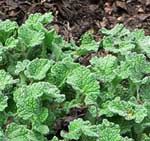Horehound Herb

The name horehound is derived from "Horus", the Egyptian god
of sky and light. Ancient herbalists prescribed it for fevers and malaria
and as an antidote for snakebites, rabid dog bites and ingested poison.
Horehound was traditionally carried in sachets as a protection against
sorcery. When mixed with ash leaves and placed in a bowl of water, horehound
is supposed to release healing vibrations and should be placed in a room
with a sick person. When drunk as a tea, the herb will promote mental
acumen and clarity.
A native of Europe, but now naturalized throughout North and South America,
horehound is a hardy perennial of the mint family — with its telltale
square stem — and, like most mints, can become invasive if not controlled.
The herb can be started from seed or cuttings in the early spring. The
seed should be sown just below the surface and cuttings should have about
a one-foot spacing. Rings of small white flowers will appear from June
to September in the second year of growth, but the leaves may be cut for
use or drying in the first year.
Horehound won't win any beauty prizes in your garden, but ironically,
when dried, the leaves and flowers make an attractive addition to arrangements
of everlastings. The herb will flourish under the most marginal of circumstances,
in poor dry soil for example along the edge of driveways and other neglected
areas. The only threat to horehound is to sit in very wet conditions over
winter. A couple of more ornamental species of the herb are silver horehound,
with its woollier leaves and whiter flowers and the denser Spanish horehound,
with pink flowers. Unfortunately, both of these are only hardy to Zone
7. The Mediterranean plant, black horehound (Ballota nigra), although
also a member of the mint family, is a different species with a very unpleasant
odor.
Other than as a tea, horehound has no culinary application, although
the herb was once used to flavor ale in England. Horehound is the champion
herb for chest problems and has enjoyed this role for thousands of years.
The Greek physician Dioscorides (AD 40-90) advocated a decoction of horehound
for tuberculosis, asthma and coughs. The herb is an effective immune booster
and is quite nutritious, containing vitamins A, B, C and E, essential
fatty acids, iron, potassium and marrubin (an expectorant). Horehound
has proven to be effective in loosening phlegm and mucus in the bronchial
tubes and in the lungs. It will also relieve coughs and sore throats.
The German government's committee of herbal experts known as Commission
E, has sanctioned horehound for use against bronchial problems, including
laryngitis.
To make your own Horehound Cough Syrup, you'll need:
½ cup of fresh horehound leaves (or ¼ cup of dried)
2 cups of water
3 cups of liquid honey
Place the horehound in a stainless steel pot with the water and bring
to the boil. Remove from the heat and allow to steep for about 10 minutes.
Strain and then add the honey. Mix well and bottle. The amount of honey
can be adjusted for taste and consistency.
For making Horehound Cough Drops:
1 cup of fresh or dried horehound
1 cup of water
2 cups of brown sugar
2 tbsp. honey
Enough icing sugar to cover finished drops
Put the horehound leaves and water in a stainless steel saucepan and
bring to the boil. Simmer for 20 minutes and then cool. Strain and squeeze
out the herbs. Put the liquid back into the pan and add the brown sugar
and the honey. While continually stirring with a wooden spoon, bring the
liquid back to simmer. Keep stirring and when the liquid falls from the
spoon in a thread, test it by dropping it into a cup of cold water. If
you have a candy thermometer, the temperature should reach at least 300
degrees F. When the mixture hardens enough to crack with your teeth, it's
ready. If you overdo it and the mixture crystallizes, just add more water
and a little more honey. When ready, pour the mixture into a lightly buttered
baking dish. When cool enough, score the top to facilitate breaking the
hardened mixture into squares or diagonals. Once broken up, shake icing
sugar over the horehound cough drops to keep them from sticking together.
Store in a moisture-proof glass jar.
About The Author:
Bruce Burnett is an award-winning writer, a chartered herbalist and author
of HerbWise: Growing Cooking Wellbeing. Read more published articles
by Bruce Burnett on his websites: http://www.bruceburnett.ca
and http://www.herbalcuisine.com
|